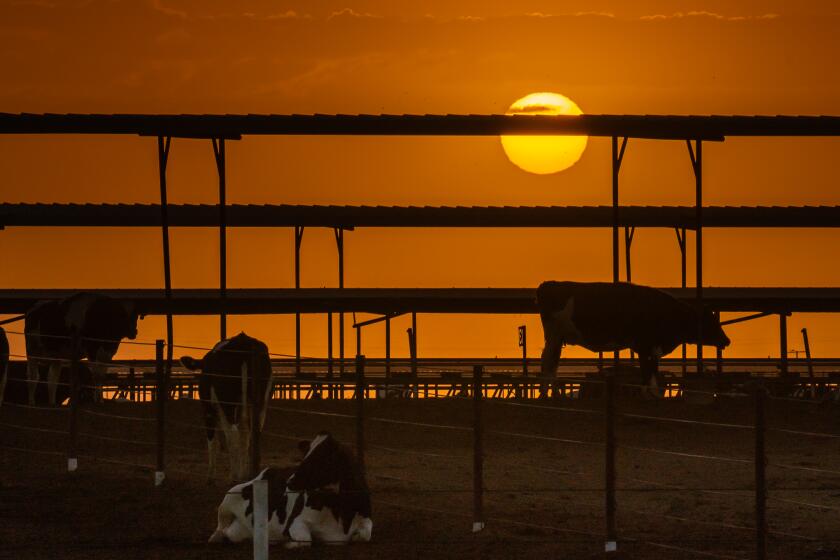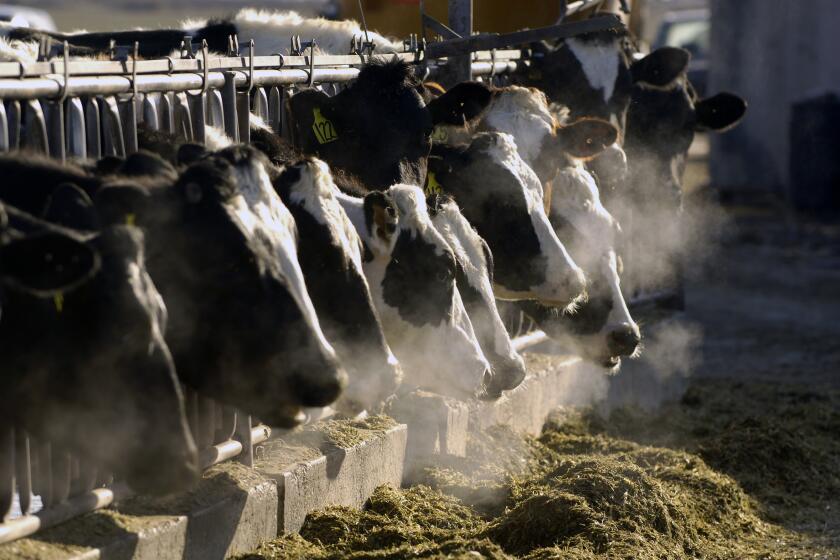
- Share via
- A teenager in British Columbia is in critical condition after being exposed to H5N1 bird flu. The source of the virus has not been determined.
- The teen is the first presumptive case of H5N1 bird flu in Canada.
Canadian health officials announced Tuesday that a teenager infected with H5N1 bird flu from an unknown source is in critical condition.
According to British Columbia Provincial Health Officer Bonnie Henry, the child was hospitalized Friday and is suffering acute respiratory distress, in the first presumptive case of H5N1 bird flu in Canada.
“Our thoughts continue to be with this person and their family,” said Henry.
Authorities believe the virus was acquired via an animal; however, the teen was not on a farm nor near any known wild birds or backyard poultry — common reservoirs for the disease.
Dairy industry experts say the virus entered California after local cows were shipped to another state and then returned to California.
According to a CBC interview with Henry, the teen did not have any contact with birds but did interact with a variety of other animals — including a dog, cats and reptiles — in the days before becoming ill. Testing on those animals has so far been negative for the virus.
The health authorities are also tracing people the teen was in contact with; so far they have not identified other infections.
The situation is “horrifying,” said Jennifer Nuzzo, director of the Pandemic Center at Brown University in Providence, R.I. “The idea that we have a child, a teenager, who is seriously ill from this virus is just really an utter tragedy. But sadly, it’s not surprising, given everything we’ve known about H5N1 and its potential to cause illness.”
She noted that since the late 1990s, when this current strain of bird flu originated in China’s Guangdong province, the fatality rate was close to 60%. That number is probably inflated, she said, as presumably most people tested for the disease were those who went to hospitals or clinics to seek treatment; people who had mild symptoms, or were asymptomatic, were probably not tested.
However, Nuzzo said, while this virus could “be a lot less deadly than what we’ve seen to date,” it could also be far more deadly than any pandemic in a long time, including COVID-19.
She said the case causes her concern for three reasons: The first is the severity of the teen’s illness. The second is that “we don’t understand how the teenager got infected,” she said. Her third concern is how government officials are dealing with this outbreak, which she described as “letting it continue to spread from animals to people, without trying to do more to get ahead of it.”
She said the virus might not end up becoming more virulent or efficient at moving among humans, but added: “I don’t think we want to wait around, [considering] the chance that it might.”
Since the virus appeared in North American wild birds in 2021, human cases have mostly been mild. Since 2022, there have been 47 human cases in the U.S. — 25 in dairy workers, 21 in poultry workers, and one case in Missouri in which the source has not yet been identified.
However, a recent study from the U.S. Centers for Disease Control and Prevention shows the virus is more widespread in dairy workers than had previously been assumed. An examination of antibodies in 115 dairy workers from Michigan and Colorado showed that eight people, or 7% of the study population, were positive for the disease — indicating workers were either not reporting illness or were asymptomatic.
Nuzzo also pointed to a recent study published in Nature, led by Yoshihiro Kawaoka, an H5N1 expert at the University of Wisconsin-Madison, that showed the virus in the first reported dairy worker infection in Texas had acquired mutations that made it more severe in animals and allowed it to move more efficiently among them — via airborne respiration.
When Kawaoka exposed ferrets to this viral isolate, 100% died. In addition, the amount of virus they were initially exposed to didn’t seem to matter. Even very low doses caused mortality.
Kawaoka told The Times in an interview that the mutations seen in this particular isolate have appeared elsewhere in past outbreaks in birds and mammals, “so in that sense, it’s a very orthodox mutation.”
Although California dairy farmers anticipated a bird flu mortality rate of less than 2%, some say between 10% and 15% of infected cattle are dying.
On Wednesday, Canadian health authorities announced that they had genetically sequenced the virus in the teen, and that it is the newer D1.1 version that has affected poultry flocks in the Pacific Northwest this fall, and was likely carried by wild birds. It is not the version being seen in dairy cows or dairy workers, which has been called B3.13. Both are of the H5N1 2.3.4.4b clade that has been wreaking havoc across North and South America since 2021, and in Europe, Asia and Africa since 2020.
Fortunately, the mutated isolate that infected the lone dairy worker in Texas has not been seen since. It’s unclear why the worker did not present with more severe symptoms.
However, there are a few hypotheses.
Kawaoka’s research has shown “inefficient replication” of the virus in human corneal cells. If the worker was exposed by a splash of contaminated milk to the eye, or a rub of the eye with a contaminated glove, the virus may have been stalled out — unable to replicate like it might if the worker was exposed via inhalation.
Nuzzo said there are other hypotheses — which she stressed are just hypotheses — including one that posits people who were exposed to the H1N1 swine flu outbreak in 2009 may have acquired some immunity to the “N1” part of the bird virus.
Another theory goes back to a person’s first influenza exposure.
There is a scientific hypothesis called the “original antigenic sin” that suggests that a person’s first exposure to a particular virus “may sort of kind of set the tone” for that person’s immune system going forward — so this worker’s first flu exposure may have provided his immune system with the defenses needed to suppress H5N1.
“There are a lot more questions than answers at this point. So there are a lot of interesting hypotheses for why the more recent cases have been mild; there’s not enough evidence to simply discard more than two decades worth of evidence about this virus that tells us that it could be quite deadly,” said Nuzzo.
As human flu season ramps up, Nuzzo said, it’s critically important that people do what they can to prevent the spread of disease.
She said both seasonal flu and H5N1 vaccines should be provided to dairy workers.
Unfortunately, she said, “our surveillance efforts for trying to find outbreaks on farms, while getting better, are still not even close to what we need to know about these outbreaks.”
In the meantime, vaccines and antiviral medications need to be on hand.
“The news of a deeply serious human case of bird flu is a massive wake-up call that should immediately mobilize efforts to prevent another human pandemic,” said Andrew deCoriolis, executive director of Farm Forward, a nonprofit that promotes humane agricultural practices. “We could have prevented the spread of bird flu on poultry farms across America, and we didn’t. We could have prevented the spread of bird flu on dairy farms, and we didn’t.
“Factory farms notorious for raising billions of sickly animals in filthy, cramped conditions provide a recipe for viruses like bird flu (H5N1) to emerge and spread,” DeCoriolis said in a statement. “We are now on the cusp of another pandemic and the agencies responsible for regulating farms and protecting public health are moving slower than the virus is spreading.”
As of Wednesday, 492 dairy herds across 15 states had been infected with H5N1. More than half, 278, are in California. Two pigs in Oregon have also been infected.









